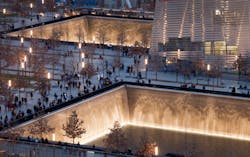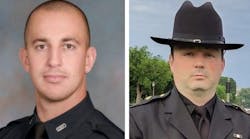Flooding at the WTC site.
During Hurricane Sandy, the site of the National September 11 Memorial and Museum complex was overcome by more than 16 million gallons of floodwater, which ruined wires and drywall and ravaged a handful of iconic artifacts.
In an emotional essay on the museum's website, director Alice Greenwald described seeing "seven feet of standing water throughout the museum."
"The humidity was thick, like a sauna," she wrote. "This was a disaster."
The site's extensive flooding is renewing protests over a plan to move the 8,584 still-unidentified remains from 9/11 victims into a repository adjacent to the base level of the museum, seven stories below ground. Family members of the dead fear that putting the remains so far under the earth-in flood zone A, no less-leaves them unnecessarily vulnerable to the elements, particularly with researchers still actively conducting DNA tests on those body parts.
"It's going to happen again," said Russell Mercer, the father of a 32-year-old firefighter who perished in the attack. "Those human remains should not be there."
Mr. Mercer's son, Scott Kopytko, died climbing the stairs of the South Tower on 9/11.
Though his corpse was never recovered, his parents still hold out hope that scientists will yet find some part of him that they can bury. "I can't even go to a cemetery and visit his grave," Mr. Mercer told The Observer. "I have an empty seat at my house on the holiday."
Prior to Hurricane Sandy, the remains were stored above ground in a parking lot adjacent to the medical examiner's 30th Street office and were removed to a secure location during the storm. When construction is completed-in late 2013 or early 2014, according to officials-all of the remains will be moved over to the repository site, where they will rest until they're sampled and transferred, one by one, to the city medical examiner's office for testing. The agency has committed to identifying every piece of bone, tissue and DNA found at Ground Zero, insofar as testing methods allow.
Mr. Mercer is afraid that when the remains are transported to the bedrock of the memorial site and there's another storm and another flood, he's going to lose his son another time.
"Is Scott going to be washed away?" he asked. "Is he ever going to be identified?"
Most of the museum's thousands of artifacts were stowed before the storm in secure locations, but some of the larger pieces, including the Last Column, the World Trade Center cross, two fire trucks and a cab, remained in the structure, shrink-wrapped to protect them from the surge. While the Port Authority installed dozens of sandbags and concrete barriers and additional water pumps, those efforts were no match for the gushing water.
Michael Frazier, the museum's spokesperson, said that despite the precautions, some artifacts were damaged. "We're doing all the work we can with our conservators to make sure any damage is remediated," he said, noting that the objects were pretty banged up to begin with, given their source. "They came from the rubble. It's a relative thing."
One construction worker faced with the task of emptying the waterlogged location was somewhat more candid. "Everything that's in there is fucked-the fire truck, the taxicab-it was so sad to watch," he said. Exposure to seawater made the metal artifacts vulnerable to corrosion, he said, and inadvertently cleaned them. "The dust, the sweat and the tears-it's washed away," he said.
It took more than a week to pump out all of the water, and the museum is still assessing how much damage the flood caused. Mr. Frazier said that some of the wiring, Sheetrock and other infrastructure needs to be replaced. The Port Authority filed a request for FEMA assistance on November 27, records show, but a dollar figure for the damage done to the site is not yet available.
Steve Plate, the director of World Trade Center Construction, noted that the museum site was especially vulnerable because it was roofless at the time of the storm. "We will continue to re-evaluate and implement additional strategic flood mitigation efforts moving forward," he said in a statement.
Mr. Frazier attributed the flooding at the museum to vulnerabilities in other areas of the World Trade Center site that were still under construction. "It is believed that the flooding would not have been as extensive had the museum, which is still under construction, been complete," Mr. Frazier said.
Mr. Frazier said the museum and the Port Authority are evaluating what additional measures, if any, need to be taken to fortify the museum and memorial, but said staff will get additional training in emergency artifact removal.
The Office of the Medical Examiner did not detail its own emergency plans for the repository.
What the museum will look like when it opens. Remains will be kept in a special room out of public view. (NS11MM)
Construction for the memorial and the museum-located below the footprint of the towers-began in 2006 following several years of back and forth among families, architects, engineers, community members and other stakeholders. Everything from the admissions price, to the construction start date to the organization of the victims' names has been contested at pulpits and in courtrooms.
The 110,000-square-foot site will have multimedia displays, archives and narratives commemorating the victims of the attacks. Portraits of the nearly 3,000 men, women and children who died will also be displayed. Visitors will walk down a sloped ramp until they reach the exhibition space at the base of the site, 70 feet below ground level. The museum area will share a wall with the repository, where a quote from Virgil will be displayed: "No day shall erase you from the memory of time." Parts of the original foundation of the Twin Towers will also be incorporated into the museum complex.
While the subterranean design was intentionally grave-like, that concept has long been contested by family members who wanted the remains to be stored above ground and entirely separate from the museum's exhibition space. Flooding was always a concern for these families, Sally Regenhard, one of the museum's most vocal opponents, told The Observer.
Those fears were heightened by the recent storm, said Ms. Regenhard, who lost her son Christian, a firefighter and former marine.
She and more than a dozen other family members are suing both the memorial and the city for the right to obtain a comprehensive contact list of victims' relatives. Ms. Regenhard hopes to use the list to mobilize an effort to store remains in something akin to the Tomb of the Unknowns, a monument dedicated to American service members who have died without identification.
Their next court date is scheduled for January 9.
"No one wants their loved ones remains floating down the drain," she said.
Amid flood fears, yet another concern is the safety of personal artifacts that are being donated to the exhibition, including bloodied watches, handwritten notes and wallets recovered from the site.
"These things are a part of history-we cannot replace them," Patricia Nilsen, who lost her sister Anne Marie Martino Cramer in the South Tower, said. "What are they doing to protect our items? We need to know what's going on."
Mr. Frazier said that it was unlikely that the museum would relinquish any items, owing to "a thorough collection policy" that requires donors to give the museum legal ownership.
Michael Burke donated his late brother's FDNY badge to the museum, and is now having second thoughts about having signed it over. "When I heard about the flood and saw the photographs, I was shocked," he said. "I want the story to be told ... and he would want the history to be told. It's not fair."
Other donors are wondering if they can get those items back.
Mr. Burke said the only silver lining in the years of construction delays and bitter debates surrounding the still-unfinished repository and museum is that their future contents were largely spared by the storm-at least this one.
"If there is one place where we know we can't predict the future, " Mr. Burke said, "it's at Ground Zero."
Copyright 2013 The New York Observer, L.P. All Rights Reserved




